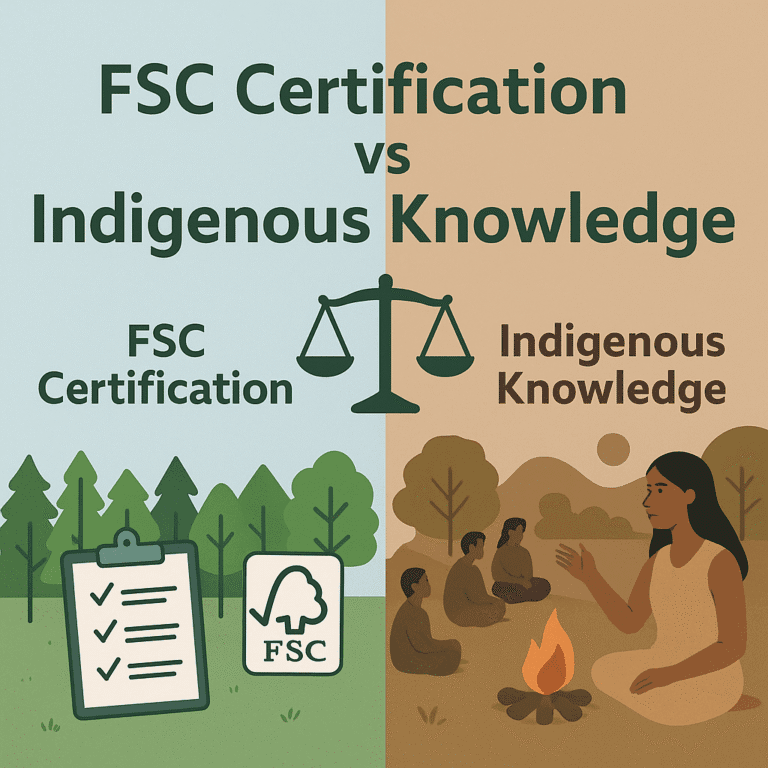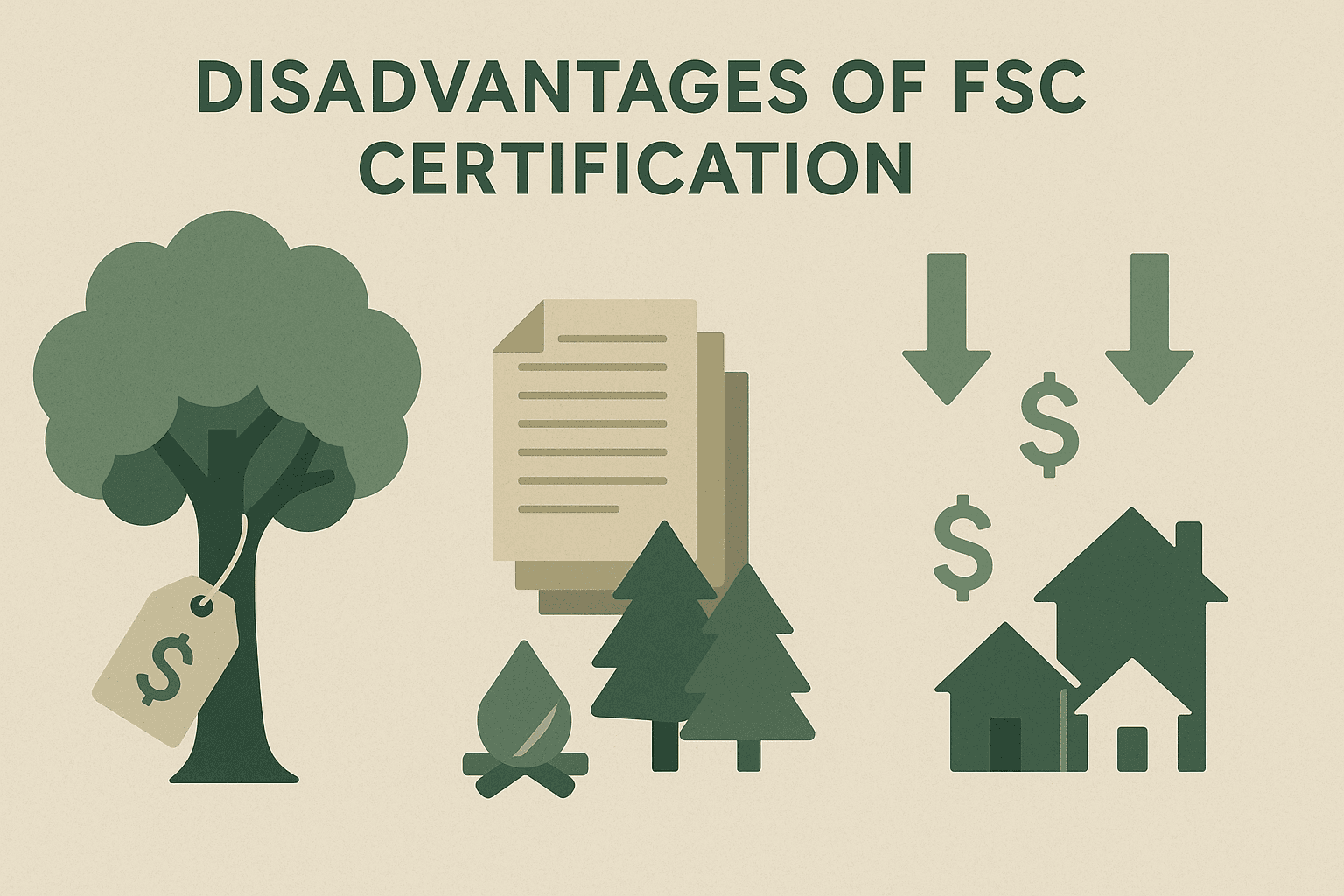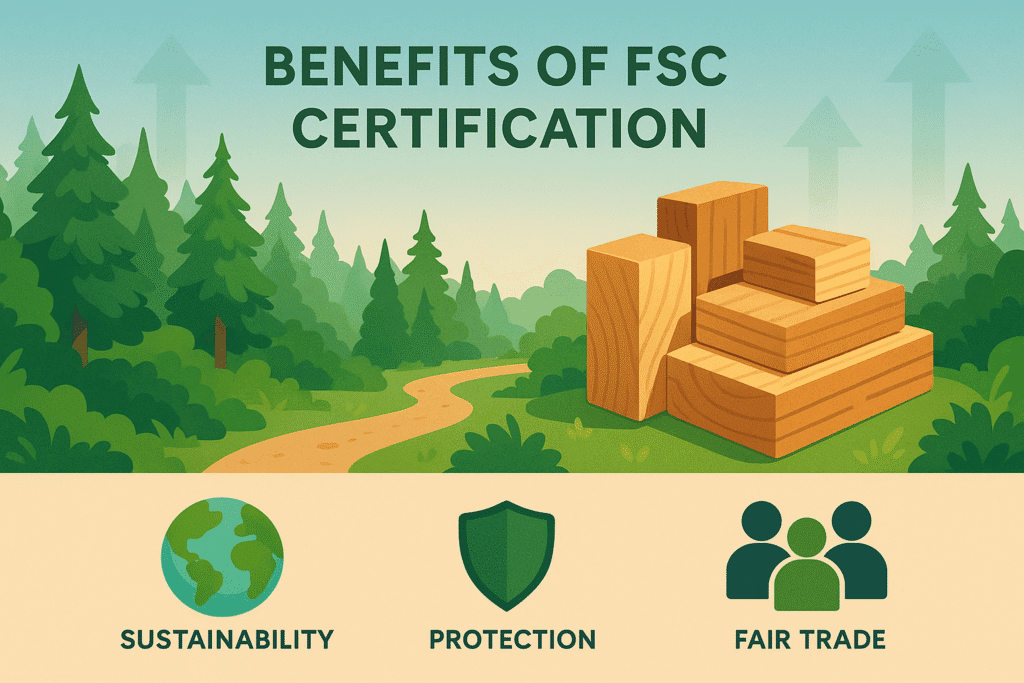
Table of Contents
ToggleWhat is FSC and indigenous knowledge
We know that forests are among Earth’s most valuable life support systems, and yet their protection is approached in various ways. And here come two prominent paths that are often discussed globally: FSC and indigenous knowledge.
FSC certification : Forest Stewardship Council is a voluntary/international standard launched in 1993. It includes our 10 principles and 70 criteria that aim to balance environmental, social, and economic values. FSC promotes sustainable logging, biodiversity protection, and respect for indigenous rights through formal processes such as Free Prior,or Informed Consent (FPIC). Products that carry the FSC label can access environmentally conscious markets worldwide. This makes FSC a bridge between responsible forestry and global trade.
Indigenous knowledge : it is not a written standard but a living heritage. Indigenous knowledge includes practices like sacred grove preservation, seasonal harvesting rules, rotational farming, and mixed land use systems that integrate biodiversity into daily life. It’s deeply embedded in cultural traditions, spiritual beliefs and social norms + also ensures that forest cafe isn’t just a rule to follow it’s a way of life.
FSC represents a modern, structured, and market-driven approach to forest stewardship; on the other hand, indigenous knowledge reflects adaptive, place-specific, and community-led care. Both aim to safeguard forests, but they operate on fundamentally different logics – one uses international governance frameworks, the other is grounded in continuity and deep ecological understanding. Both help counter selective logging with an extremely bad impact.
FSC and indigenous knowledge: A deep comparison
FSC Certification vs Indigenous Knowledge — Deep Comparison
| Feature | FSC Certification | Indigenous Knowledge (IK) |
|---|---|---|
| Governance | Governance is handled through a formal board structure with documented rules, voting procedures, and official records. | Decisions are made by community clans or councils,that are often led by elders and rooted in local traditions. |
| Rights & Consent | FSC It follows a formal FPIC process with documented steps, checklists, and written approvals. | Consent is integrated into daily community life, It often gets implicitly and understood without formal documentation. |
| Environmental Focus | Environmental protection is based on set standards, measurable metrics, and performance indicators. | Environmental care is guided by traditional knowledge of species, seasons and cultural stories. |
| Monitoring | Monitoring is done through third-party audits and periodic written reports. | Monitoring is done through daily observation, oral accounts, and community memory. |
| Traceability | Products are tracked through a clear supply chain with labels and documentation. | Resources are connected to specific places through cultural ties rather than product labeling. |
| Market Access | Certification opens access to eco-friendly markets and allows products to earn premium prices. | Market benefits are indirect, the value is placed more above on cultural significance rather than sales. |
| Scalability | The system is designed to be applied consistently across multiple regions. | The approach is deeply local and difficult to replicate in other areas. |
| Cost & Funding | Certification requires financial investment for audits and ongoing compliance, often supported by grants. | The process requires little monetary cost but relies heavily on community trust and shared responsibility, with funding that is often limited. |
| Conflict Handling | Conflicts are resolved through legal systems and formal grievance procedures. | Disputes are handled by community leaders through mediation and a focus on restoring harmony. |
| Adaptability | Standards can be updated, but the process is often slow and formal. | Practices adapt quickly based on seasonal changes and lived experience. |
| Knowledge Transfer | Knowledge is passed on through structured training programs and workshops. | Knowledge is shared through storytelling, apprenticeships, cultural rituals, and songs. |
| Legal Standing | Certification is recognized by many brands and supported by some legal frameworks. | Traditional systems may lack formal legal recognition but carry strong moral authority. |
| Cultural Fit | The certification process is neutral and standardized, which may overlook local cultural practices. | Culture is at the heart of Indigenous Knowledge which inudes those practices that are deeply connected to specific places and people. |

Limitations of Indigenous knowledge
Indigenous knowledge (IK) carries centuries of wisdom but in today’s fast changing world it faces hurdles that limit its wider application and at last FSC and indigenous knowledge are being compared.
Scalability of Indigenous knowledge is one of the major challenges. These practices are often tailored to specific ecosystems and cultural settings, and this makes them hard to apply on a global scale without losing their essence. A method that thrives in the Amazon might fail in dry Savanna.
Lack of moral documents is another limitation. Much of indigenous knowledge is passed down orally which means valuable details will lost with each new generation. Because without records, every detail couldn’t be transferred via oral, and it’s harder to defend these practices in legal policy debates.
Policy recognition is also weak. Global climate and conservation frameworks often prioritize modern science and ignore community-led systems, even when they are proven effective in the locality.
The U.S. Fish & Wildlife Service notes that Traditional Ecological Knowledge captures seasonal patterns of plants, animals, and landscapes to guide forestry, farming, and hunting practices.
At last, in my opinion, Indigenous knowledge is vulnerable to external pressure, such as deforestation, industrial expansion, and land grabs. This external pressure can erase centuries of ecological stewardship in few short years. The knowledge is strong but the systems protecting it are often fragile.

Disadvantages of FSC certification
FSC certification sets a global standard for responsible forestry, but it is not without flaws. Due to FSC many companies are safe from legal actions for carbon emissions by selective logging. Here are the disadvantages of FSC certification:-
1. Implementation gaps are common- audits may approve operations that still harm biodiversity or marginalized local communities, especially in regions with weak oversight.
2. Cost and complexity can exclude small forest owners. The paperwork, fees, and technical requirements often favour large companies over local cooperatives.
3. Over-reliance on market forces means certified products depend on consumer demand. If buyers aren’t willing to pay more then sustainable practices may be abandoned.
4. Cultural nuances are often missed– standardized rules can overlook the deep relationship certain communities have with their forests. These rules treat them as a resource rather than living heritage.
5. Green washing risks- some companies use FSC logos mainly for marketing. Despite this they make minimal on-ground changes.
6. Limited coverage- Many high-risk forests remain outside FSC programs. This leaves large areas unmanaged or poorly protected.
7. Slow adaptation to crises – The certification process can be too rigid to respond quickly to sudden threats like illegal logging spikes or climate-driven forest fires.
Benefits of FSC certification
- Market credibility– products with FSC labels gain trust in eco-conscious markets. It often opens premium pricing opportunities for them.
- Verified sustainability– clear standards ensure wood and paper come from responsibly managed forests.
- Global recognition – FSC is accepted in over 80 countries thus it helps businesses to meet both local and international compliance needs.
- Protection of worker rights – standards include fair wages, safe working conditions, and respect for community consent.
- Biodiversity safeguards– certificate rules protect endangered species, habitats, and prevent large-scale clear-cutting.
- Transparent audits – regular checks maintain accountability and detect bad practices.

Benefits of Indigenous knowledge
Indigenous knowledge offers a depth of forest stewardship that no standardized global certification can replicate. Its strength lies in centuries of lived experience where cultural traditions and ecological understanding are tightly woven together.
One of the most valuable aspects of indigenous knowledge is its place-specific adaptability. Every community develops practices that are tuned to the local climate, soil, wildlife, and seasonal rhythms. This allows for sustainable resource use without exhausting the land. For example, rotational harvesting and fallow periods ensure the forest’s natural regeneration.
IK also provides biodiversity protection on a scale that goes beyond compliance. For instance, sacred groves are often kept untouched for spiritual reasons that is becoming safe havens for rare species. Similarly, traditional mixed land use systems create diverse habitats instead of monoculture plantations.
Another key benefit is long-term resilience. These practices have been tested over hundreds of years, surviving droughts, floods and social changes. Instead of fixed global rules indigenous knowledge dynamically adapts to fluctuations of environmental conditions.
Cultural continuity is another dimension often overlooked. Forests are not just resources for indigenous communities, they are living relatives that are tied to identity, language, and storytelling. Protecting them protects entire ways of life.
Finally, indigenous knowledge naturally integrates social consent and participation. Decision-making happens within the community. It ensures that forest use aligns with collective values rather than distant market demands. Indigenous knowledge offers an irreplaceable blueprint for balancing human needs with ecological health whenever they are respected and supported.
FAQS
What is the difference between FSC and Indigenous Knowledge?
FSC certification is a global standard that checks if forests are managed responsibly based on selected criteria. On the other hand indigenous knowledge comes from generations of local experience where forest care is based on cultural traditions and deep understanding of the local ecosystem.
FSC and indigenous knowledge, which one is better ?
FSC certification provides credibility in global markets but indigenous knowledge ensures practices are adapted to specific local conditions. The most sustainable approach often blends the two systems.
Why should we preserve Indigenous Knowledge alongside FSC standards?
Indigenous knowledge protects biodiversity, supports cultural heritage and offers sustainable practices tested over centuries. When FSC and indigenous knowledge are combined, they create a stronger and more inclusive model for forest conservation.
